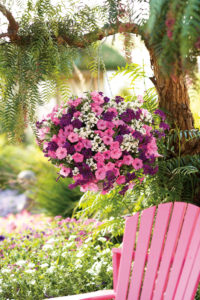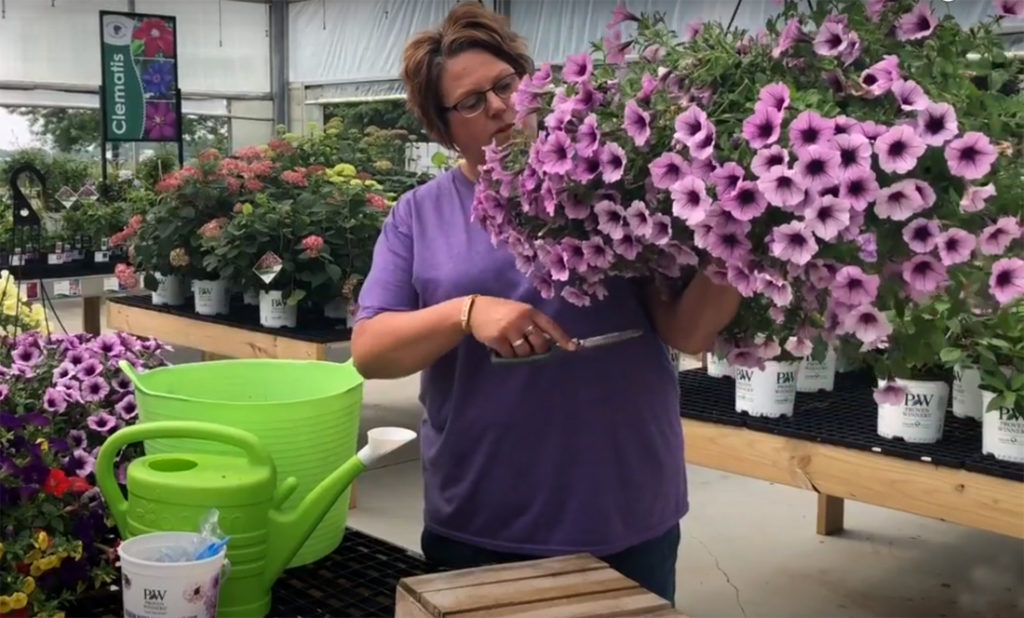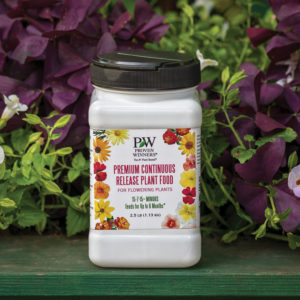 We’re all enthralled with the beauty of our hanging baskets and containers in spring. We bring them home from the garden center in picture perfect condition, hang them up or set them in a prominent place on our front porch and enjoy them every day. We remember to water—usually—and love seeing how they continue to grow and bloom.
We’re all enthralled with the beauty of our hanging baskets and containers in spring. We bring them home from the garden center in picture perfect condition, hang them up or set them in a prominent place on our front porch and enjoy them every day. We remember to water—usually—and love seeing how they continue to grow and bloom.
What’s missing from this scene? Food! Flowers love to be fed! Some are hungrier than others, but all enjoy a basic amount of food each week to be able to have the energy to grow bigger and produce more flowers. It’s easy to forget to feed our plants until we look out the window one day and wonder why they aren’t as vibrant as they once were.
Why do container plants need to be fed so often?
Containerized plants are different than plants in the ground in that they rely solely on the contents of the container for all the nutrients and water they need. In the ground, a plant’s roots can grow deeper to seek moisture and they extract minerals found naturally in the soil. They don’t have that same opportunity when they are growing in a container.
Another key difference when growing plants in containers is that the nutrients in the soil are literally flushed out the drainage hole over time. If you don’t replace them, your plants will begin to starve. That’s why it’s good to mix some continuous release plant food that will be released slowly to the plants in your potting soil. It’s also why regular feeding with quickly absorbable water soluble plant food is necessary. We recommend feeding your flowering annuals once a week.
Annual flowers also require more nutrients than perennials and shrubs because it takes a whole lot of energy to produce flowers all season long. While perennials and shrubs bloom on a cycle, plants like petunias bloom from the time you plant them all the way into the fall. The fuel they use to continually produce flowers comes in large part from the food you provide. Will your annual plants die if you don’t feed them? Probably not, but they certainly won’t live up to their potential. Don’t you want to keep seeing those beautiful blooms?
Plants typically get leggy—meaning they grow weaker, longer than usual stems—when they are lacking in nutrients or are growing in too much shade. You can avoid leggy growth by feeding your plants regularly and making sure they are getting plenty of sunshine.

My plants are already leggy! How do I fix it?
It’s OK! It happens to the best of us. There’s an easy solution.
If your plants look stretched and have fewer flowers on weak stems, it’s time to give them a haircut. If they are growing in a hanging basket, trim all of the plants in it so they grow back out evenly. Remember the bowl haircuts of the 1970s? It’s time to relive those days! Take a sharp pair of scissors and trim off the bottom 25% of all the trailing stems or up to the bottom of the hanging basket. If there are some scraggly looking stems coming out the top of the basket, trim those back by a similar amount.
You know how you feel better—lighter even—after you’ve had your haircut? That’s how your plants will feel after you give them a trim. Treat them by taking them out to lunch afterwards and feeding them water soluble plant food. It will jumpstart their new growth and they will fill right back out in no time with loads more blooms.
Watch a video of how to trim and feed your hanging baskets here.
Lastly, check to make sure your plants are getting enough sun in the location you were growing them. If lack of sunlight made them become leggy before, it will do so again even if you give them a haircut. Remember that full sun plants need 6+ hours of direct sunlight per day, including some afternoon sun. Sun loving plants like petunias, calibrachoas and verbenas will be happy with a full day of sunshine. Part sun/part shade loving plants will need 4-6 hours of sun per day. If it is too shady for your hanging basket or container that became leggy, it’s time to find a brighter location.
Want to learn more about caring for your annual plants? Read the full article.

